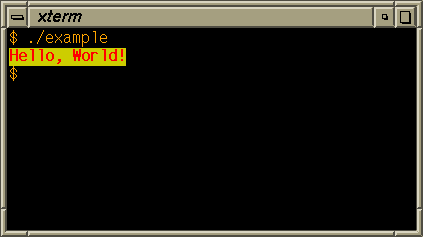ANSI Escape Sequences
ANSI escape codes are used to control formatting, colour, cursor position, and other output options on terminal emulators. The ncurses library is a convenient method to change these options, but Unicode characters and 256 colours are not supported by the Fortran ncurses interface. Instead, it is often easier to implement the desired output with ANSI escape sequences only.
Some of the sequences are listed in the following table:
| Sequence | Description |
|---|---|
| Esc[Line;ColumnH Esc[Line;Columnf |
Moves the cursor position. If no position is specified, the cursor moves to the the upper-left corner (line 0, column 0). |
| Esc[ValueA | Moves the cursor up by the specified number of lines. The sequence is ignored if the cursor is already on the top line. |
| Esc[ValueB | Moves the cursor down by the specified number of lines. The sequence is ignored if the cursor is already on the bottom line. |
| Esc[ValueC | Moves the cursor forward by the specified number of columns. The sequence is ignored if the cursor is already on the rightmost column. |
| Esc[ValueD | Moves the cursor backward by the specified number of columns. The sequence is ignored if the cursor is already on the leftmost column. |
| Esc[2J | Erases display. |
| Esc[K | Erases line by clearing all characters from the cursor position to the end of the line. |
The intrinsic Fortran routine achar() is used to output the
escape character. The example below just moves the cursor and colourises some
text.
! ansi.f90
program main
implicit none
character(len=*), parameter :: ESC = achar(27)
write (*, '(a)', advance='no') ESC // '[2J' ! Clear screen.
write (*, '(a)', advance='no') ESC // '[44;1m' // ESC // '[38;5;200m' // 'Hello, World!'
write (*, '(a)') ESC // '[0m' ! Reset colours.
end program mainCompile and run the program with:
$ gfortran14 -o ansi ansi.f90
$ ./ansiInstead of achar(), we can also use
UCS-2 to escape and embed ANSI escape sequences into
strings.
M_escape
The M_escape module abstracts the output formatting through parameters and routines for ANSI terminal control. Either use GNU make or the Fortran Package Manager to build the library:
$ git clone https://github.com/urbanjost/M_escape
$ cd M_escape/
$ fpm build --profile releaseThe static library libM_escape.a along the module files
m_escape.mod and m_list2.mod will be written to
directory build/gfortran/M_escape/ afterwards.

- Fig. 1: Output with foreground and background colour set through ANSI escape sequences
The example has to import module M_escape first.
! example.f90
program main
use :: m_escape
implicit none
print '(a)', color('Hello, World!', fg=FG_RED, bg=BG_YELLOW, style=BOLD)
end program mainThe example program just has to be linked against the M_escape library:
$ gfortran14 -o example example.f90 libM_escape.aFig. 1 shows the output of the example.
Fortran Libraries
- FACE: Fortran 2008 environment for ANSI colours and styles
- Fortran Standard Library: Features ANSI module
- M_escape: Fortran library for ANSI terminal control
References
- Wikipedia: ANSI escape code
- Table of ANSI escape sequences
| < LAPACK | [Index] | ncurses > |